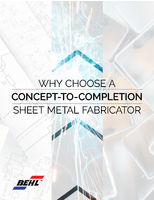Publishing Plant Save Energy, Water with Munters Oasis IEC Units

Largest IEC Project in State
Four indirect evaporative cooling (IEC) units were recently installed at the California Department of General Services, Office of State Publishing in Sacramento - making it the largest IEC project in the state. The Munters Oasis(TM) IEC modules, with a total air flow capacity of 354,000 cubic feet per minute (CFM) and a sensible cooling production of over 704 tons of cooling, provide preconditioning for the 100% outdoor air required for the plant's production area.
THE STATE'S DILEMMA
For 50 years, the state of California's publishing facility pre-cooled outdoor air entering the facility with 57 degrees F water pumped from a well and fed to chilled water coils located in the two penthouse mechanical rooms on the roof. The warm water leaving the coils was discharged into the American river.
This process had to be altered when it was discovered that the well water was polluted, and the Environmental Protection Agency (EPA) threatened to assess fines to the state for polluting the American river. The plant required a quick solution to the problem. With summer approaching, plant employees would not stay on the job without proper pre-cooling of the outdoor air.
The plant turned to Munters, a leader in air treatment solutions, to develop a solution. Munters suggested use of its dry evaporative cooling technology.
IEC TECHNOLOGY
Unlike direct evaporative cooling (DEC) systems that cool outdoor air by the evaporation of water which enters the building, IEC or dry evaporative cooling uses a horizontal polymer tube air-to-air heat exchanger. Scavenger outdoor air is drawn upward across the outside of the horizontal tubes while water is sprayed through the tube bundle. The outside surface of the tubes are chilled to the ambient wet bulb (WB) temperature which, on a hot day in Sacramento, is usually 30 degrees F lower than the ambient dry bulb (DB) condition. Air entering the building is drawn through the inside of the horizontal polymer tubes and dry cooled without the addition of any moisture.
The cooling process is identical to that of refrigeration cooling in that the energy level or enthalpy of the dry cooled air is reduced as it travels through the air-to-air heat exchanger. The hot and humid scavenger air is exhausted to the atmosphere off the top of the IEC module.
The amount of heat exchanger surface area in the polymer tubes is critical to the heat transfer performance of the air-to-air heat exchanger just as it is in any thermodynamic process. It's estimated that the horizontal polymer tubes installed in the four Munters IEC modules, if laid end to end, would stretch for 28 miles.
The efficiency of the system is measured by the approach of the entering air ambient DB temperature to the ambient WB temperature with full air flow through both sides of the air-to-air heat exchanger. Project specifications called for a 70% approach of the DB to the WD condition. As an example, if ambient DB is 100 degrees F and the WB is 70 degrees F, the outdoor air should be cooled from 100 degrees F DB to 79 degrees F DB within the horizontal wetted tubes.
ENERGY SAVINGS REALIZED
Originally, personnel at the plant evaluated an air cooled water chiller as a solution to solve the pre-cooling problem. This plan required the installation of a 700 ton chiller in the parking lot on grade, and the chilled water piped up to the two rooftop penthouses and connected to the pre-cooling coils.
The parking lot air cooled chiller would have consumed 1.2 KW of electrical energy per ton including the water pumping energy up to the rooftop. The IEC modules, with an energy consumption of only 0.2 KW per ton, were not only more energy efficient but would cost the state of California less to install. Estimated peak electrical demand reduction on the hottest days of summer would exceed 700 KW compared to the air cooled water chiller.
SAVING WATER
In addition to resolving its EPA problem with the termination of well water usage, the state was intent on minimizing the potable make up water consumed by the evaporative cooling systems.
A Dolphin non chemical water treatment system was specified for the water recirculation sumps of both the IEC systems to be installed on the roof and the existing air washers in the penthouse mechanical equipment rooms. These pulse power water treatment systems were originally developed for cold pasteurization in the liquid food industry.
The device encapsulates water hardness minerals and particulate into a non-adherent powder that is harmlessly deposited in the bottom of the sump. The Dolphin unit controls scaling of the wetted heat exchanger surfaces and reduces biological growth in the sump water. Under proper operation, the pulse power component will maintain clean sump water with low bacteria counts free of biofilm and will eliminate the breeding ground for the amplification of Legionella and other waterborne pathogens.
Also, the polymer tube IEC systems have been tested for over six years in California's most severe evaporative cooling environment: Death Valley. With summer design temperatures above 121 F and potable water with an average hardness of 1500 PPM, two systems installed at the CALTRANS Cow Creek Maintenance Facility, near the town of Bad Water, demonstrated a self-cleaning feature that helps keep the wetted surfaces of the polymer tube free of water hardness deposits. During start-up of the supply and scavenger fans, the heat exchanger tubes flex slightly due to air pressure differences from the wet to the dry side of each tube. The flexing causes the calcium deposits to drop harmlessly into the sump.
The combination of the Dolphin and the self-cleaning feature of the polymer tubes will allow the State to operate its IEC water sumps at higher cycles of concentration, thereby reducing the amount of wasted water required for purging the minerals and particulate matter from the water recirculation system.
MEASURED PERFORMANCE
In late August, a test was run on the IEC module Marked IEC-3. Ambient temperatures at 2 p.m. were 95.5 degrees F DB and 68.5 degrees F WB (See Figure 1). The Munters IEC unit was cooling the outdoor air leaving the dry side polymer tubes down to 74.1 degrees F DB and 61.5 degrees F WB. This represents an approach to the ambient WB condition of 79.26%, 11% above the specified performance requirements with full CFM flow through both sides of the air-to-air heat exchanger. (See Graphic 2)
The dry side flow through the heat exchanger is 98,200 CFM constant volume. The sensible cooling produced is calculated to be 192.6 tons. Assuming an 80% saturation efficiency for the air washers located downstream of the IEC module, the supply air to the building would be in the range 64 degrees F DB, ignoring fan heat.
The sprays on the air washers are modulated on and off to maintain a room relative humidity of around 60% which is optimal for the printing process. Leaving air temperature set point off the IEC coolers is controlled by varying the wet side air mass flow with variable frequency drives (VFD) on the scavenger fans.
For more information, please contact Mike Scofield via email at cmscofield@aol.com.
About Munters
Munters is a global leader in energy efficient air treatment solutions based on expertise in humidity and climate control technologies. Customers are served in a wide range of segments, and manufacturing and sales are carried out via the Group's own companies in about 30 countries. The Group has close to 2,200 employees and annual net sales of about SEK 3.7 billion. Munters is owned by Nordic Capital Fund VII.
For more information, see www.munters.us.
Contacts:
Jacqueline McIlrath
Marketing Manager
Munters
Phone: 210-249-3818
jmcilrath@munters.com




